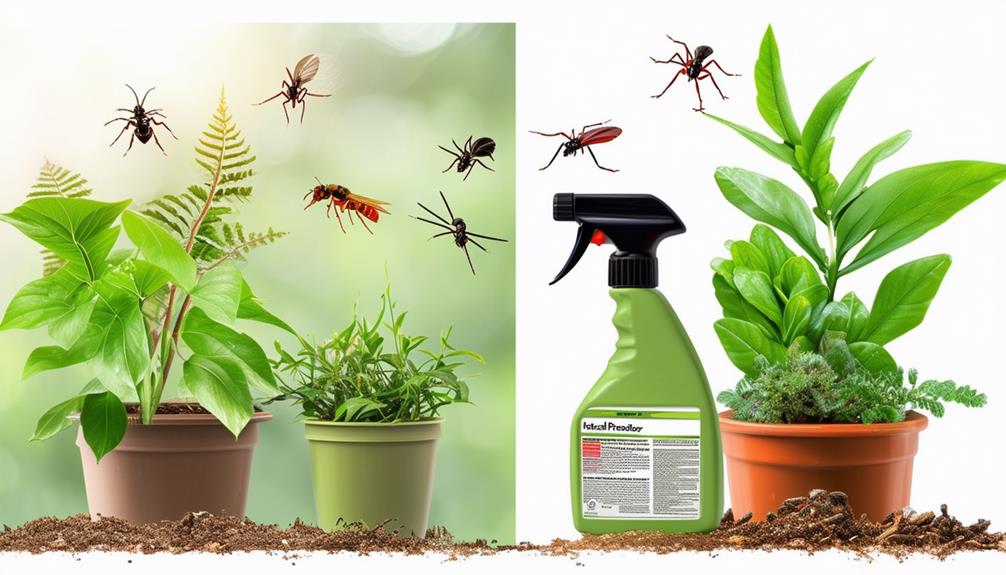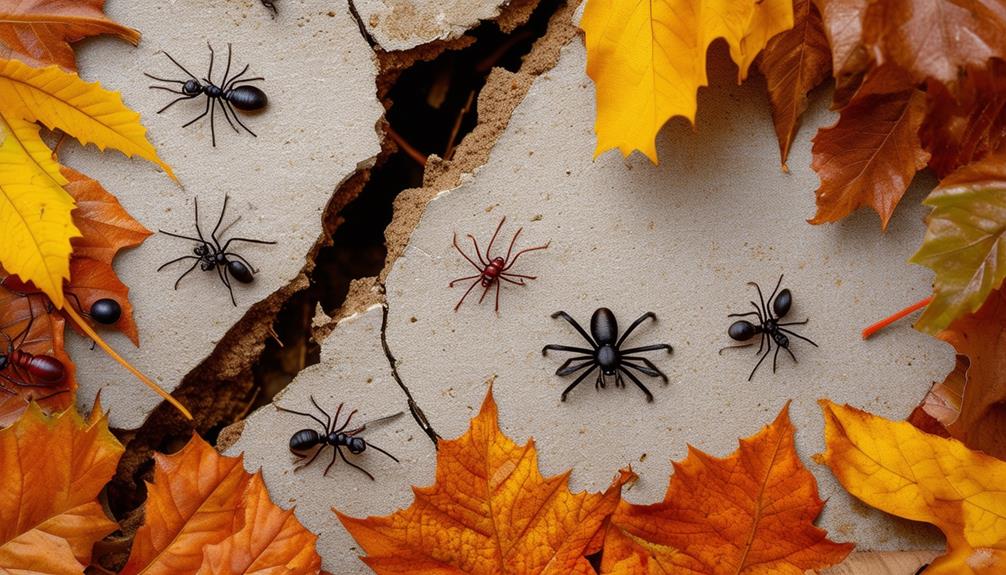When it comes to managing pests, the choices you make can have lasting effects on the environment. From chemical solutions that raise concerns about contamination to biological methods that aim to restore ecological balance, each approach carries its set of consequences. As you navigate through the complexities of pest control, consider how your decisions today can shape the world around you tomorrow.
Key Takeaways
- Chemical pest control may contaminate soil and water.
- Biological control targets specific pests, preserving ecosystems.
- Physical methods are non-toxic but may be labor-intensive.
- Non-toxic pest control reduces water and soil contamination risks.
- Integrated pest management promotes sustainable and eco-friendly practices.
Chemical Pest Control Environmental Impact
Chemical pest control methods pose a significant threat to the environment due to their potential to contaminate soil and water sources with harmful pesticides. The environmental impact of using chemical pesticides in pest control is alarming as these substances can have far-reaching consequences.
Pesticides not only target pests but can also disrupt local ecosystems by affecting non-target species. Over time, the overuse of chemical treatments can lead to imbalances in predator-prey relationships, causing cascading effects in the environment. Additionally, pests developing resistance to pesticides due to excessive use is a concerning issue associated with chemical pest control practices.
Michigan’s water resources, in particular, are at risk of contamination from the environmental impact of chemical pest control methods. Considering these factors, it’s important to evaluate and potentially reduce the reliance on chemical pest control to mitigate the negative effects on the environment.
Biological Pest Control Effects
Biological pest control methods demonstrate a sustainable approach to managing pest populations by utilizing natural predators, parasites, and pathogens instead of synthetic chemicals. These methods have a targeted impact on specific pests, minimizing harm to non-target species. By deploying beneficial insects like ladybugs, nematodes, or using biological agents such as Bacillus thuringiensis (Bt), pest populations can be controlled effectively. One of the key advantages of biological pest control is its ability to maintain ecological balance by operating within the natural ecosystem.
Implementing biological pest control measures not only reduces the reliance on chemical pesticides but also helps in conserving biodiversity. This approach fosters a more eco-friendly way of managing pests while promoting the health of the environment. By harnessing natural mechanisms to control pest populations, biological pest control methods play an important role in sustainable agriculture practices. The targeted nature of these methods ensures that the ecological balance is maintained, making them an essential tool in integrated pest management strategies.
Physical Pest Control Impact
Physical pest control methods, such as using nets, screens, or traps, offer a non-toxic and environmentally safe approach to managing pests. However, these techniques can be labor-intensive and may not be suitable for large-scale infestations.
While effective on a small scale, physical pest control may not completely eradicate pests in cases of extensive infestations.
Non-Toxic Pest Control
Utilizing non-toxic pest control methods, particularly through physical techniques like barriers or traps, presents a sustainable and environmentally conscious approach with minimal direct impact compared to chemical alternatives.
Integrated Pest Management (IPM) strategies emphasize the use of eco-friendly alternatives, reducing the reliance on harmful pesticides. Physical barriers, such as door sweeps and screens, act as effective preventive measures to keep pests out of buildings without the need for toxic chemicals.
Additionally, tools like sticky traps or light traps target specific pests, ensuring that non-target organisms remain unharmed. By implementing non-toxic pest control measures, the risk of water and soil contamination from pesticides is reduced, promoting a more sustainable and environmentally friendly pest management system.
Mechanical Pest Control
Mechanical pest control methods, involving physical barriers or manual removal techniques, offer environmentally safe approaches to effectively manage pests in various settings. These strategies, such as using nets, traps, screens, or handpicking pests, can help prevent infestations without the use of harmful chemicals.
While physical pest control is ecologically friendly, practical limitations exist. Labor-intensive methods like manual removal may not completely eradicate pests in all scenarios. Although effective on a small scale, mechanical pest control may not be practical for extensive infestations. The reliance on physical barriers and manual labor can be time-consuming and may not be feasible for large-scale pest problems.
Despite its environmental benefits, the practicality of mechanical pest control depends on the specific circumstances of the infestation.
Natural Pest Control
Implementing natural pest control methods offers a sustainable and eco-friendly approach to managing pest populations without relying on chemical pesticides.
Physical pest control methods focus on using barriers, traps, and physical means to manage pests. This method includes sealing entry points, installing screens, and using sticky traps to prevent pests from entering buildings. It’s environmentally friendly and avoids the use of harmful chemical pesticides.
Physical barriers and traps are effective for managing pests in various settings, including residential, commercial, and agricultural areas. By opting for non-toxic pest control measures, individuals can greatly reduce their environmental impact and promote sustainable pest management practices.
Embracing natural pest control not only helps in pest management but also contributes to a healthier ecosystem.
Cultural Pest Control Consequences
How do the consequences of cultural pest control methods impact sustainable pest management practices?
Cultural pest control, with its focus on environmentally friendly practices and natural deterrents, plays an important role in sustainable pest management. Here are three key points to take into account:
- Environmental Impact: Cultural pest control methods have a lower environmental impact compared to chemical interventions. By utilizing strategies like crop rotation and waste management, these practices promote a healthier ecosystem and reduce the reliance on harmful pesticides.
- Integration with IPM: Cultural pest control is an integral part of Integrated Pest Management (IPM) approaches. Incorporating cultural practices into IPM strategies allows for a more holistic and effective pest management system that minimizes environmental harm.
- Effectiveness and Adaptability: The effectiveness of cultural pest control methods can vary depending on the specific pests and the cultural practices implemented. To achieve sustainable results, it’s essential to proactively adapt these methods to suit the unique pest control needs of different environments.
Environmental Impact of IPM
IPM offers substantial environmental benefits through its integrated approach to pest management.
By reducing the need for chemical pesticides, IPM helps minimize the risks of water and soil contamination.
This method promotes a more sustainable and eco-friendly way of controlling pests, prioritizing the use of less toxic alternatives first.
IPM Benefits Environment
Enhancing environmental sustainability in pest control, Integrated Pest Management (IPM) benefits ecosystems by reducing reliance on chemical pesticides and promoting natural predators and biological controls.
- Reduced Chemical Dependency: IPM minimizes the use of chemical pesticides, lowering the risk of soil and water contamination.
- Ecosystem Preservation: By encouraging natural predators and biological controls, IPM helps maintain ecological balance within ecosystems.
- Long-Term Effectiveness: Implementing IPM strategies decreases the likelihood of pests developing resistance to pesticides, ensuring the continued efficacy of pest control measures.
With these benefits, IPM not only safeguards the environment but also contributes to the overall health of ecosystems, highlighting its significance in sustainable pest control practices.
IPM Reduces Chemical Use
Utilizing a combination of biological, cultural, and mechanical controls, Integrated Pest Management (IPM) effectively reduces the reliance on chemical pesticides in pest control practices.
By incorporating methods such as monitoring, habitat modification, and natural predator introduction, IPM helps to minimize pesticide use, promoting sustainable pest control that’s environmentally friendly.
This approach not only protects human health but also aims to maintain pest management effectiveness while reducing risks to non-target organisms and decreasing pesticide runoff.
IPM strategies play an essential role in supporting ecosystem balance by focusing on prevention rather than solely relying on chemical solutions.
Embracing IPM can lead to a significant decrease in the overall environmental impact of pest control methods.
Eco-Friendly Pest Repellents
To promote environmentally friendly pest control practices, incorporating eco-friendly pest repellents like peppermint oil, vinegar, citrus peels, and essential oils can effectively deter insects without the use of harmful chemicals. These natural solutions offer a safe and sustainable alternative to traditional pest control methods.
- Peppermint Oil: Known for its ability to deter spiders and ants, peppermint oil serves as a natural repellent without the need for harsh chemicals.
- Vinegar and Water Mixture: A mixture of vinegar and water acts as a non-toxic repellent for ants and other insects, promoting eco-friendly pest control practices.
- Citrus Peels: Repelling spiders and ants naturally, citrus peels provide a sustainable option for keeping pests at bay without resorting to chemical-based repellents.
Sustainable Pest Management Practices
Sustainable pest management practices prioritize minimizing environmental impact while effectively controlling pests through a combination of techniques such as Integrated Pest Management (IPM), biological controls, cultural practices, and limited chemical usage.
IPM, a key component of sustainable pest management, involves monitoring pest levels, employing natural predators, and utilizing physical barriers to reduce the need for chemical interventions.
Biological pest controls, such as introducing predator insects or pathogens specific to the pest species, offer an environmentally friendly alternative to synthetic pesticides.
By emphasizing the judicious use of pesticides and fertilizers, sustainable pest management minimizes the risk of chemical residues in the environment and promotes the health of non-target organisms.
Implementing these eco-friendly practices not only aids in pest control but also contributes to reduced pollution, enhanced biodiversity, and overall ecosystem well-being.
Embracing sustainable pest management strategies can lead to a harmonious balance between effective pest control and environmental preservation.
Humane Pest Control Benefits
In humane pest control, prioritizing the use of natural predators and deterrents is key to effectively managing pests while minimizing harm. By employing eco-friendly pest control methods, you can’t only address pest issues but also contribute to a healthier environment. Here are three benefits of humane pest control:
- Manage Pests Efficiently: Utilizing natural predators and deterrents helps in controlling pest populations without resorting to harmful chemicals. This approach targets the root of the problem, leading to long-term pest management solutions.
- Preventative Measures: By identifying and addressing the reasons that attract pests, humane pest control focuses on preventing infestations rather than just reacting to them. This proactive stance reduces the reliance on reactive measures that can be detrimental to the environment.
- Sustainable Practices: Adopting sustainable pest management practices not only minimizes harm to non-target species but also supports overall ecosystem health. Eco-friendly products used in humane pest control make certain that the methods employed are safe and sustainable for the environment.
Promoting Healthy Ecosystems
Promoting healthy ecosystems involves implementing strategies that maintain biodiversity and minimize harm to non-target species in pest management practices. Integrated Pest Management (IPM) stands out as a key approach that reduces the reliance on chemical pesticides, fostering a balanced ecosystem.
By incorporating natural predators and biological controls into pest management, biodiversity is preserved, and the negative impacts on non-target species are minimized. Techniques like crop rotation and companion planting play an essential role in supporting healthy ecosystems by naturally deterring pests and enhancing plant diversity.
Additionally, organic farming practices contribute greatly to environmental sustainability by steering clear of synthetic chemicals that can disrupt ecosystems. Employing traps and barriers in pest control methods offer a targeted pest management solution that reduces environmental repercussions compared to using broad-spectrum chemicals.
Embracing these methods not only effectively manages pests but also promotes the overall health of ecosystems.
Frequently Asked Questions
What Are the Environmental Impacts of Pest Control?
When considering the environmental impacts of pest control, you must acknowledge the potential for wildlife displacement, soil contamination, water pollution, air quality issues, and biodiversity loss. These factors play a vital role in evaluating the sustainability of pest control practices.
What Are the Consequences of Using Common Pest Control Methods?
When you rely on common pest control methods, you risk causing soil contamination, disrupting wildlife, and harming water sources. Chemical exposure from these practices can lead to habitat destruction, toxic runoff, and ecological imbalances.
What Are the Negative Effects of Pest Control?
When using pest control methods, be aware of the negative effects. Chemical exposure can harm wildlife and cause soil contamination. Water pollution may result, impacting air quality. Consider these consequences before implementing pest control measures.
What Are the Environmental Effects of Pesticides?
You’ve got to understand the big picture. Pesticides mess with soil, water, and air. They throw off wildlife and mess with biodiversity. Chemical residues stick around, causing sustainability issues in the long haul.





